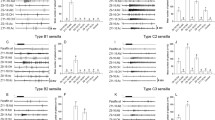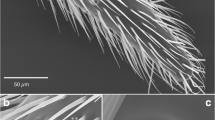Abstract
Single-cell electrophysiological recordings were obtained from olfactory receptor neurons in sensilla trichodea on male antennae of the heliothine species Heliothis subflexa and the closely related congener H. virescens. A large percentage of sensilla (72% and 81%, respectively, of all sensilla sampled) contained a single odor-responsive receptor neuron tuned to the major pheromone component of both species, Z-11-hexadecenal. A second population of sensilla on H. subflexa antennae (18%) housed receptor neurons that were tuned to Z-9-hexadecenal but also responded with less sensitivity to Z-9-tetradecenal. A similar population of sensilla (4%) on H. virescens male antennae housed receptor neurons that were shown to be tuned specifically only to Z-9-tetradecenal, with no response to even high dosages of Z-9-hexadecenal. A third population of sensilla (comprising 8% and 16% of the sensilla sampled in H. subflexa and H. virescens, respectively) housed two olfactory receptor neurons, one of which was tuned to Z-11-hexadecenyl acetate and the other tuned to Z-11-hexadecenol. In H. subflexa the Z-11-hexadecenyl acetate-tuned neuron also responded to Z-9-tetradecenal with nearly equivalent sensitivity. The behavioral requirements of males of these two species for distinct pheromonal blends was, therefore, reflected by the subtle differences in the tuning properties of antennal olfactory receptor neurons.










Similar content being viewed by others
Abbreviations
- MGC:
-
macroglomerular complex
- ORN:
-
olfactory receptor neuron
- Z9–14:Ald:
-
(Z)-9-tetradecenal
- Z9–16:Ald:
-
(Z)-9-hexadecenal
- Z11–16:Ac:
-
(Z)-11-hexadecenyl acetate
- Z11–16:Ald:
-
(Z)-11-hexadecenal
- Z11–16:OH:
-
(Z)-11-hexadecenol
References
Almaas TJ, Christensen TA, Mustaparta H (1991) Chemical communication in heliothine moths I. Antennal receptor neurons encode several features of intra- and interspecific odorants in the corn earworm moth Helicoverpa zea. J Comp Physiol A 169:249–258
Baker TC, Fadamiro HY, Cossé AA (1998) Moth uses fine tuning for odour resolution. Nature 393:530
Berg BG, Tumlinson J, Mustaparta H (1995) Chemical communication in heliothine moths. IV. Receptor neuron responses to pheromone compounds and formate analogues in the male tobacco budworm moth Heliothis virescens. J Comp Physiol A 177:527–534
Berg BG, Almaas TJ, Bjaalie JG, Mustaparta H (1998) The macroglomerular complex of the antennal lobe in the tobacco budworm Heliothis virescens: specified subdivision in four compartments according to information about biologically significant compounds. J Comp Physiol A 183:669–682
Berg BG, Galizia CG, Brandt R, Mustaparta H (2002) Digital atlases of the antennal lobe in two species of tobacco budworm moths, the oriental Helicoverpa assulta (male) and the American Heliothis virescens (male and female). J Comp Neurol 446:123–134
Christensen TA (1997) Anatomical and physiological diversity in the central processing of sex-pheromone information in different moth species. In: Cardé RT, Minks AK (eds) Insect pheromone research: new directions. Chapman and Hall, New York, pp 184–193
Christensen TA, Mustaparta H, Hildebrand JG (1991) Chemical communication in heliothine moths. II. Central processing of intra- and interspecific olfactory messages in the corn earworm moth Helicoverpa zea. J Comp Physiol A 169:259–274
Christensen TA, Mustaparta H, Hildebrand JG (1995) Chemical communication in heliothine moths. VI. Parallel pathways for information processing in the macroglomerular complex of the tobacco budworm moth Heliothis virescens. J Comp Physiol A 177:545–557
Cossé AA, Todd JL, Baker TC (1998) Neurons discovered in male Helicoverpa zea antennae that correlate with pheromone-mediated attraction and interspecific antagonism. J Comp Physiol A 182:585–594
Fadamiro HY, Cossé AA, Baker TC (1999) Fine-scale resolution of closely spaced pheromone and antagonist filaments by flying male Helicoverpa zea. J Comp Physiol A 185:131–141
Grant AJ, Mayer MS, Mankin RW (1989) Responses from sensilla on the antennae of male Heliothis zea to its major pheromone component and two analogs. J Chem Ecol 15:2625–2634
Hansson BS (1995) Olfaction in Lepidoptera. Experientia 51:1003–1027
Hansson BS, Christensen TA (1998) Functional characteristics of the antennal lobe. In: Hansson BS (ed) Insect olfaction. Springer, Berlin Heidelberg New York, pp 125–161
Hansson BS, Löfstedt C, Roelofs WL (1987) Inheritance of olfactory response to sex pheromone components in Ostrinia nubilalis. Naturwissenschaften 74:497–499
Hansson BS, Almaas TJ, Anton S (1995) Chemical communication in heliothine moths. V. Antennal lobe projection patterns of pheromone-detecting olfactory receptor neurons in the male Heliothis virescens (Lepidoptera: Noctuidae). J Comp Physiol A 177:535–543
Hartstack AW Jr, Lopez JD, Klun JA, Witz JA, Shaver TN, Plimmer JR (1980) New trap designs and pheromone bait formulation for Heliothis. Proc Beltwide Cotton Prod Res Conf, pp 132–135
Heath RR, Mitchell ER, Cibrian-TovarJ (1990) Effect of release rate and ratio of (Z)-11-hexadecen-1-ol from synthetic pheromone blends on trap capture of Heliothis subflexa (Lepidoptera: Noctuidae). J Chem Ecol 16:1259–1268
Hildebrand JG (1995) Analysis of chemical signals by nervous system. Proc Natl Acad Sci USA 92:67–74
Hildebrand JG, Shepherd GM (1997) Mechanisms of olfactory discrimination: converging evidence for common principles across phyla. Annu Rev Neurosci 20:595–631
Kaissling K-E (1974) Sensory transduction in insect olfactory receptors. In: Jaenicke L (ed) Biochemistry of sensory functions. Springer, Berlin Heidelberg New York, pp 243–273
Klun JA, Plimmer JR, Bierl-Leonhardt BA, Sparks AN, Chapman OL (1979) Trace chemicals: the essence of sexual communication systems in Heliothis species. Science 204:1328–1330
Klun JA, Plimmer JR, Bierl-Leonhardt BA, Sparks AN, Primiani M, Chapman OL, Lee GH, Lepone G (1980a) Sex pheromone chemistry of female corn earworm moth, Heliothis zea. J Chem Ecol 6:165–175
Klun JA, Plimmer JR, Bierl-Leonhardt BA, Sparks AN, Primiani M, Chapman OL, Lepone G, Lee GH (1980b) Sex pheromone chemistry of female tobacco budworm moth, Heliothis virescens. J Chem Ecol 6:177–183
Klun JA, Leonhardt BA, Lopez JD Jr, Lachance LE (1982) Female Heliothis subflexa (Lepidoptera: Noctuidae) sex pheromone: chemistry and congeneric comparisons. Environ Entomol 11:1084–1090
Laster ML (1972) Interspecific hybridization of Heliothis virescens and Heliothis subflexa. Environ Entomol 1:682–687
Pope MM, Gaston LK, Baker TC (1984) Composition, quantification, and periodicity of sex pheromone volatiles from individual Heliothis zea females. J Insect Physiol 30:943–945
Proshold FI, Martin DF, Laster ML, Raulston JR, Sparks AN (1983) Release of backcross insects on St. Croix to suppress the tobacco budworm (Lepidoptera: Noctuidae): methodology and dispersal of insects. J Econ Entomol 76:885–891
Quero C, Baker TC (1999) Antagonistic effect of (Z)-11-hexadecen-1-ol on the pheromone-mediated flight of Helicoverpa zea (Boddie) (Lepidoptera: Noctuidae). J Insect Behav 12:701–709
Quero C., Fadamiro HY, Baker TC (2001) Responses of male Helicoverpa zea to single pulses of sex pheromone and behavioural antagonist. Physiol Entomol 26:106–115
Ramaswamy SB, Randle SA, Ma WK (1985) Field evaluation of the sex pheromone components of Heliothis virescens (Lepidoptera: Noctuidae) in cone traps. Environ Entomol 14:293–296
Roelofs WL, Hill AS, Cardé RT, Baker TC (1974) Two sex pheromone components of the tobacco budworm moth, Heliothis virescens. Life Sci 14:1555–1562
Sparks AN, Raulston JR, Lingren PD, Carpenter JE, Klun JA, Mullinix BG (1979) Field response of male Heliothis virescens to pheromone stimuli and traps. ESA Bull 2:268–274
Teal PEA, Tumlinson JH (1997) Effects of interspecific hybridization between Heliothis virescens and Heliothis subflexa (Lepidoptera: Noctuidae) on the sex pheromone communication system. In Cardé RT, Minks AK (eds) Insect pheromone research: new directions. Chapman and Hall, New York, pp 535–547
Teal PEA, Heath RR, Tumlinson JH, McLaughlin JR (1981) Identification of a sex pheromone of Heliothis subflexa (GN.) (Lepidoptera: Noctuidae) and field trapping studies using different blends. J Chem Ecol 7:1011–1022
Teal PEA, Tumlinson JH, Heath RR (1986) Chemical and behavioral analyses of volatile sex pheromone components released by calling Heliothis virescens (F.) females (Lepidoptera: Noctuidae). J Chem Ecol 12:107–125
Tumlinson, JH, Hendricks PE, Mitchell ER, Doolittle RE, Brennan MM (1975) Isolation, identification and synthesis of the sex pheromone of the tobacco budworm. J Chem Ecol 1:203–214
Van der Pers JNC, Den Otter CJ (1978) Single cell responses from olfactory receptors of small ermine moths to sex-attractants. J Insect Physiol 24:337–343
Vetter RS, Baker TC (1983) Behavioral responses of male Heliothis virescens in a sustained-flight tunnel to combinations of seven compounds identified from female glands. J Chem Ecol 9:747–759
Vetter RS, Baker TC (1984) Behavioral responses of male Heliothis zea moths in sustained flight-tunnel to combinations of four compounds identified from female sex pheromone gland. J Chem Ecol 10:193–202
Vickers NJ (2002) Defining a synthetic pheromone blend attractive to male Heliothis subflexa under wind tunnel conditions. J Chem Ecol 28:1255–1267
Vickers NJ, Baker TC (1997) Chemical communication in heliothine moths. VII. Correlation between diminished responses to point-source plumes and single filaments similarly tainted with a behavioral antagonist. J Comp Physiol A 180:523–536
Vickers NJ, Christensen TA (2003) Functional divergence of spatially conserved olfactory glomeruli in two related moth species. Chem Senses 28:325–338
Vickers NJ, Christensen TA, Mustaparta H, Baker TC (1991) Chemical communication in heliothine moths. III. Flight behavior of male Helicoverpa zea and Heliothis virescens in response to varying ratios of intra- and interspecific sex pheromone components. J Comp Physiol A 169:275–280
Vickers NJ, Christensen TA, Hildebrand JG (1998) Combinatorial odor discrimination in the brain: Attractive and antagonist odor blends are represented in distinct combinations of uniquely identifiable glomeruli. J Comp Neurol 400:35–56
Acknowledgements
This research was funded by a collaborative NSF grant between T.C.B. (IBN-9910783) and N.J.V. (IBN-9905683). We thank Jennifer Harris for rearing many of the H. virescens moths used in this study. David Kelly, Alan Pack, Matt Pond and Keri Swearingen assisted in maintaining the H. subflexa colony. Many thanks to Dr. Fred Gould and co-workers for providing the animals used to establish this colony and suggestions for its maintenance.
Author information
Authors and Affiliations
Corresponding author
Rights and permissions
About this article
Cite this article
Baker, T.C., Ochieng’, S.A., Cossé, A.A. et al. A comparison of responses from olfactory receptor neurons of Heliothis subflexa and Heliothis virescens to components of their sex pheromone. J Comp Physiol A 190, 155–165 (2004). https://doi.org/10.1007/s00359-003-0483-2
Received:
Revised:
Accepted:
Published:
Issue Date:
DOI: https://doi.org/10.1007/s00359-003-0483-2




